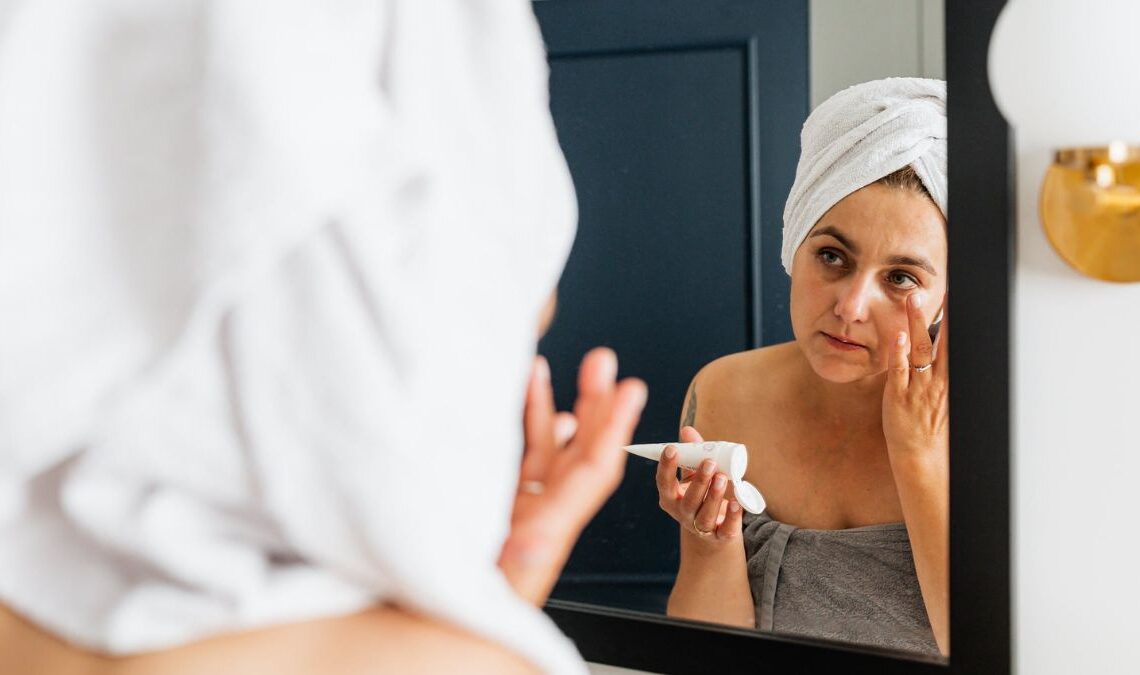Banish Summer Shine: Mastering Oil Control
Summer’s heat can amplify oil production, leading to a complexion that feels more slick than sleek. Don’t resign yourself to a season of shine! By tweaking your skincare routine, you can maintain a fresh, matte finish all summer long.
Lighten Up Your Routine
The foundation of summer skincare is a gentle, yet effective cleanse. Opt for a mild cleanser that removes impurities without stripping your skin’s natural oils, which can trigger even more oil production. Follow with a lightweight, alcohol-free toner to balance your skin’s pH. The goal is to keep your pores clear and your skin feeling fresh, not tight or dry.
Hydrate Strategically
It might seem counterintuitive, but oily skin needs hydration too. The key is to choose the right kind. Look for oil-free serums and moisturizers that deliver essential hydration without adding extra shine. Gel-based formulas are often a great choice for summer, as they absorb quickly and leave a matte finish. Ingredients like hyaluronic acid can attract moisture to the skin without clogging pores.
Exfoliate for Clarity
Regular exfoliation is crucial for preventing clogged pores and breakouts, which are common concerns during the summer months. Incorporate a gentle chemical exfoliant, such as an AHA (alpha hydroxy acid) or BHA (beta hydroxy acid), into your routine once or twice a week. AHAs are great for surface-level exfoliation, while BHAs can penetrate deeper into pores to dissolve oil and debris.
Protect and Prime
Sunscreen is non-negotiable, even on cloudy days. However, heavy sunscreens can exacerbate oiliness. Choose a lightweight, non-comedogenic sunscreen with a matte finish. Consider using a tinted sunscreen or BB cream to even out your skin tone without the need for heavy foundation. On days when you don’t need full coverage, let your skin breathe by skipping makeup altogether.
Nourish From Within
What you eat can have a significant impact on your skin. While diet isn’t the sole cause of oily skin, reducing your intake of greasy, processed foods may help regulate oil production. Focus on a balanced diet rich in fruits, vegetables, and whole grains to support healthy skin from the inside out. Staying hydrated by drinking plenty of water is also essential.
Data source: Dang Lifestyle, Esthetic Haus etc. 2024
Winter Skin SOS: Hydration to the Rescue
Winter’s cold, dry air can wreak havoc on your skin, leaving it feeling tight, itchy, and uncomfortable. Fortunately, with a few strategic adjustments to your skincare routine, you can keep your skin feeling soft, supple, and hydrated all season long.
Embrace Hydrating Heroes
The key to combating winter dryness is to incorporate hydrating ingredients into every step of your skincare routine. Look for products containing humectants like glycerin and hyaluronic acid, which draw moisture from the air into the skin. Ceramides are also essential, as they help to strengthen the skin’s natural barrier, preventing moisture loss. Urea is another beneficial ingredient, as it gently exfoliates while also hydrating the skin. Finally, don’t underestimate the power of occlusives like petroleum jelly, which create a protective barrier to seal in moisture.
Humidify Your Habitat
One of the most effective ways to combat winter dryness is to add moisture back into the air with a humidifier. Place a humidifier in your bedroom or living room to create a more comfortable and hydrating environment for your skin. This simple step can make a noticeable difference in your skin’s hydration levels.
Layer for Lockdown
Layering your skincare products is essential for locking in hydration during the winter months. Start with a lightweight hydrating serum containing humectants like hyaluronic acid. Follow with a richer, occlusive moisturizer to effectively reduce water loss, especially in harsh weather. This creates a protective barrier against the elements, keeping your skin feeling soft and hydrated all day long.
Target Trouble Spots
Pay special attention to areas that are more prone to dryness, such as your lips and hands. Regularly apply lip balm and hand cream throughout the day, especially after washing your hands. Consistency is key to maintaining soft, hydrated skin in these vulnerable areas.
Transitioning to Fall: A Seamless Skincare Shift
As the leaves change color and the air turns crisp, it’s time to transition your skincare routine to address the changing needs of your skin. Shifting to a fall routine is essential for maintaining healthy, radiant skin.
Prioritize Hydration
As autumn arrives, lower humidity can lead to dryness. Incorporating a thicker, creamier moisturizer is beneficial. Look for ingredients like hyaluronic acid, shea butter, or ceramides to reinforce your skin’s natural barrier.
Upgrade Your Moisturizer
Switching to a richer moisturizer helps combat the drying effects of cooler weather. These ingredients help lock in moisture and keep your skin supple. Internal hydration is just as important; drink plenty of water and eat hydrating foods.
Sunscreen is Still Essential
Even as summer fades, UV exposure remains a concern. Continue to apply sunscreen daily to protect your skin from sun damage. Choose a broad-spectrum sunscreen with an SPF of 30 or higher, and apply it every morning as the final step in your skincare routine.
Gentle Cleansing is Key
Harsh cleansers can strip your skin of its natural oils, especially during the fall. Opt for gentle, hydrating cleansers that won’t cause irritation. These cleansers help maintain your skin’s moisture balance, preventing dryness and discomfort.
Exfoliate Mindfully
Regular exfoliation helps remove dead skin cells, revealing a smoother, brighter complexion. However, over-exfoliating can lead to sensitivity, so limit it to once or twice a week. Gentle exfoliation supports healthy skin turnover without causing irritation.
Spring Awakening: Soothing Sensitive Skin During Allergy Season
Spring brings blooming flowers and sunshine, but also increased allergens that can irritate sensitive skin. Adjusting your skincare routine with allergy-safe products can help you enjoy the season comfortably.
Understanding Spring Allergens
Spring sees a rise in pollen and mold spores, leading to skin reactions like redness, itchiness, and rashes. Recognizing these triggers is the first step in protecting your skin.
Key Ingredients for Sensitive Skin
Look for products containing colloidal oatmeal or niacinamide. These ingredients calm inflammation and soothe irritated skin, providing relief from allergic reactions.
Gentle Cleansing and Moisturizing
During spring, opt for fragrance-free cleansers and barrier-repair moisturizers specifically designed for sensitive skin. Gentle products help maintain skin health without causing further irritation.
Seasonal Hair Transformations: A Year-Round Guide to Hair Color
Changing your hair color with the seasons is a fun way to refresh your look. It’s all about finding shades that complement the time of year and your personal style.
Seasonal Shifts in Color Trends
Beauty experts have noticed that people are choosing hair colors based on the changing seasons, influenced by fashion, lifestyle, and whether they want something easy to maintain or a bold statement. The trends are all about adapting to the time of year.
Spring and Summer Hues
When spring and summer roll around, think about lighter, brighter colors. Warmer blondes, sun-kissed highlights, and soft pastel shades are popular choices. These colors reflect the playful and energetic vibes of the warmer months.
Autumn and Winter Tones
As the leaves change, so do hair color preferences. Fall is the time for richer, deeper hues like mocha brown, ebony, and ruby wine. These shades capture the cozy and sophisticated feeling of the season.
Low-Maintenance vs. Statement Colors
For those who prefer a simpler approach, low-maintenance colors like “beachy brunette” or “lived-in blondes” are great because they grow out seamlessly. If you’re looking for a dramatic change, consider statement colors like fiery reds or vivid neons to really stand out.
Q&A
Question 1: What are the key differences in skincare routines recommended for summer versus winter?
Answer: Summer routines focus on oil control, using light cleansers, oil-free moisturizers, and regular exfoliation to combat excess shine. Winter routines prioritize hydration, incorporating humectants like hyaluronic acid, occlusives like ceramides and petroleum jelly, and potentially a humidifier to combat dryness caused by low humidity and indoor heating.
Question 2: What specific ingredients are recommended for addressing oily skin in summer and dry skin in winter?
Answer: For oily skin in summer, look for oil-free serums and moisturizers with a matte finish. For dry skin in winter, prioritize ingredients like glycerin, ceramides, urea (for gentle exfoliation and hydration), and petroleum jelly to lock in moisture and strengthen the skin barrier. Hyaluronic acid is beneficial in both seasons, but its use might need adjustment based on the specific climate and skin type.
Question 3: How should I adapt my skincare routine for the transition into fall and spring?
Answer: Fall requires a shift towards richer moisturizers containing ingredients like hyaluronic acid, shea butter, or ceramides to combat the drying effects of cooler weather. Spring, particularly for sensitive skin, necessitates allergy-safe products with ingredients like colloidal oatmeal or niacinamide to soothe irritation from pollen and mold. Gentle cleansing is crucial in both seasons.
Question 4: Besides topical skincare, what other factors influence skin health throughout the year?
Answer: Diet plays a significant role. Reducing greasy foods can help control oiliness, while a balanced diet supports overall skin health. Internal hydration (drinking plenty of water) is also crucial, especially during drier seasons. Furthermore, consistent sunscreen use is essential year-round to protect against UV damage.







